Predictions & Data for this entry
| Model: std | climate: Cfa, Dfa, Dfb | migrate: | phylum: |
| COMPLETE = 2.9 | ecozone: THn | food: bxCi, biHs | class: |
| MRE = 0.140 | habitat: 0iTg, 0iTh, 0iTf | gender: Dg | order: |
| SMSE = 0.118 | embryo: Tnsfm | reprod: O | family: |
Zero-variate data
| Data | Observed | Predicted | (RE) | Unit | Description | Reference |
|---|---|---|---|---|---|---|
| ab | 23 | 24.24 | (0.05393) | d | age at birth | HernPete2007 |
| tx | 30 | 31.78 | (0.05937) | d | time since birth at fledging | BrenHern2020 |
| tp | 100 | 100.5 | (0.005407) | d | time since birth at puberty | SchoAbbo1974, Bayer |
| tR | 365 | 365 | ( 0) | d | time since birth at 1st brood | guess |
| am | 2336 | 2556 | (0.0941) | d | life span | Zamm1986 |
| Li | 26 | 26.2 | (0.007629) | cm | ultimate total length | Shan1994 |
| Wwb | 6.5 | 5.805 | (0.107) | g | wet weight at birth | NewsBeac2008 |
| Wwx | 182.9 | 32.97 | (0.8198) | g | wet weight at fledging | RobeLind1966 |
| Wwp | 194.2 | 113.4 | (0.416) | g | wet weight at first reproduction | RobeLind1966 |
| Ww14 | 33 | 33.34 | (0.01039) | g | wet weight at 14d since birth | Bayer |
| Wwi | 200 | 214.1 | (0.07055) | g | ultimate wet weight | Bayer |
Uni- and bivariate data
| Data | Figure | Independent variable | Dependent variable | (RE) | Reference |
|---|---|---|---|---|---|
| aWe |  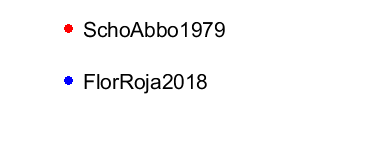 | age | embryo wet weight | (0.3245) | SchoAbbo1979 |
| aWe2 |   | age | embryo wet weight | (0.0557) | FlorRoja2018 |
| tLe | 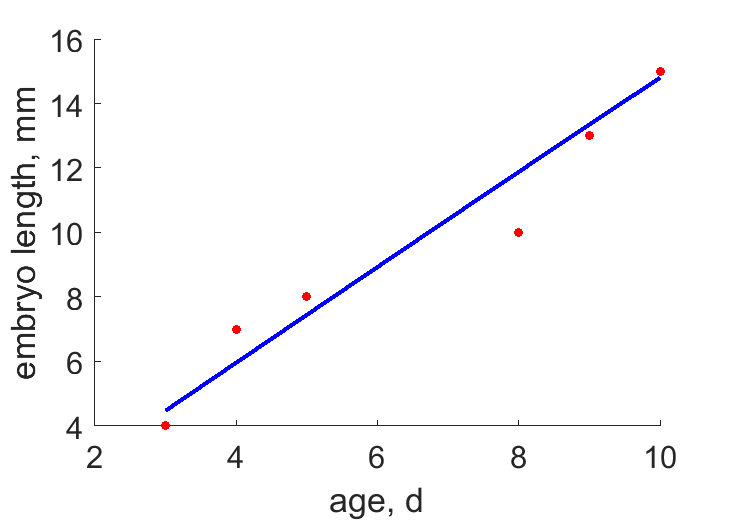 | age | embryo length | (0.07886) | Hans1954 |
| tN0 |  | time since birth | cumulated number of eggs | (0.2618) | Bayer |
| tW | 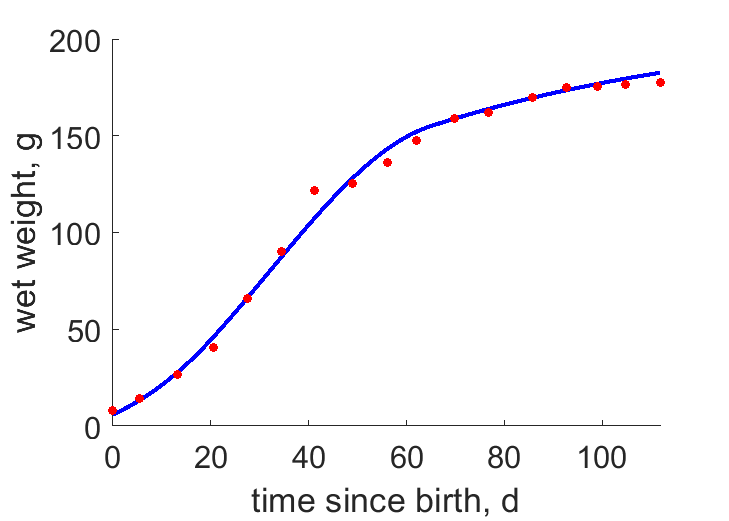 | time since birth | wet weight | (0.0275) | JoneHugh1978 |
| tW2 | 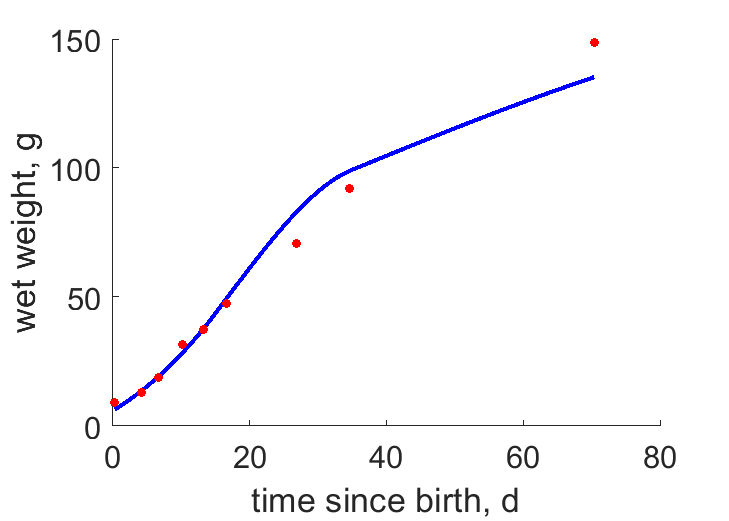 | time since birth | wet weight | (0.08872) | Lyon1962 |
| tW3 |  | time since birth | wet weight | (0.07992) | NewsBeac2008 |
| tWw0 | 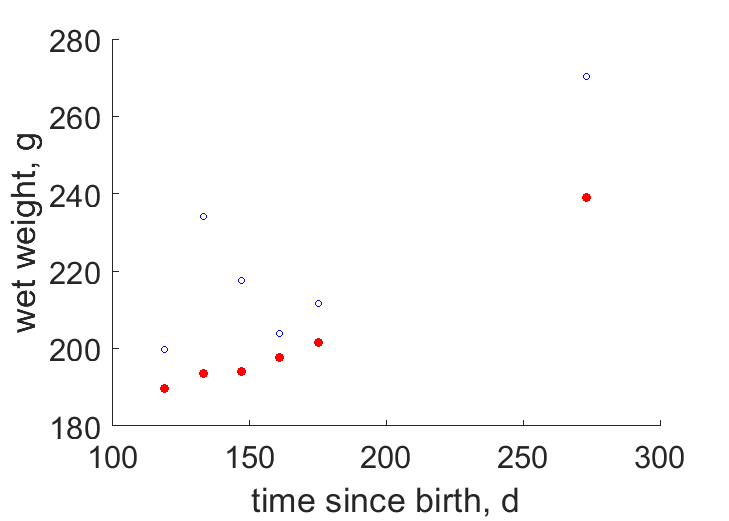 | time since birth | wet weight | (0.09993) | Bayer |
Pseudo-data at Tref = 20°C
| Data | Generalised animal | Colinus virginianus | Unit | Description |
|---|---|---|---|---|
| v | 0.02 | 0.0122 | cm/d | energy conductance |
| p_M | 18 | 300.7 | J/d.cm^3 | vol-spec som maint |
| k_J | 0.002 | 0.01176 | 1/d | maturity maint rate coefficient |
| k | 0.3 | 0.2833 | - | maintenance ratio |
| kap | 0.8 | 0.1629 | - | allocation fraction to soma |
| kap_G | 0.8 | 0.8083 | - | growth efficiency |
| kap_R | 0.95 | 0.95 | - | reproduction efficiency |
Discussion
- The entries assumes all data are performed in the thermoneutral zone. Data from SwanWein1997 which are outside of the thermoneutral zone are not included.
- mod_1: early juveniles are assumed to have a higher scaled func response than the reference value of 1.
- mod_1: added the bayer data set - assumptions reprod buffer has no water. to simplify computations we use constant E0 computed at f=1, and also do not subtract the weight of the egg released from the computation of the total weight.
- mod_1: modified age at puberty, removed egg weight and kept weight at birth. Removed tN by GentSurl2005 as the age at start and feeding history from that experiment was not known.
- mod_1: removed data on time and size at first reproduction, replaced with with time and size at puberty. This is known for quail, contrary to most birds.
- mod_1: changed Wwi which used to be 250g and set it to 200. The general idea is that adults eat more when laying eggs.
- mod_1: zero weight is put to aWe by SchoAbbo1979.
- mod_2: Pseudo-data point k is used, rather than k_J; Data set tp and parameter t_R are added, the latter replacing clutch interval t_N. Postnatal T is based on PrinPres1991, see get_T_Aves. See further the revision page, theme puberty
Facts
- There are many natural strains of bobwhite; few domesticated strains have been intentionally developed (Ref: oecd2006)
- The bobwhite is distributed from southeastern Ontario (Canada) to Guatemala and in Cuba but reaches its highest density in the eastern United States and Mexico (Ref: oecd2006)
- Body size also increases from south to north in its native range with birds in Chiapas, Mexico, averaging 129 g, whereas those in the eastern United States weigh about 172 g. (Ref: oecd2006)
- Bobwhite nest in the spring with clutch sizes of 10 to 15 eggs. (Ref: oecd2006)
- Body temperature of 38.9 in summer and 37.7 in winter - we use the summer temperature in this entry (Ref: SwanWein1997)
- mod_1: ovary + oviduct is 3.8% of total weight (at the end of photostimulation) (Ref: CainLien1985)
Bibliography